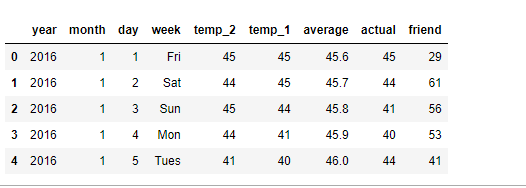天气最高温度预测任务
我们要完成三项任务:
- 使用随机森林算法完成基本建模任务
基本任务需要我们处理数据,观察特征,完成建模并进行可视化展示分析
- 观察数据量与特征个数对结果影响
在保证算法一致的前提下,加大数据个数,观察结果变换。重新考虑特征工程,引入新特征后观察结果走势。
- 对随机森林算法进行调参,找到最合适的参数
掌握机器学习中两种经典调参方法,对当前模型进行调节
# 数据读取
import pandas as pd
features = pd.read_csv('data/temps.csv')
features.head()

数据表中
- year,moth,day,week分别表示的具体的时间
- temp_2:前天的最高温度值
- temp_1:昨天的最高温度值
- average:在历史中,每年这一天的平均最高温度值
- actual:这就是我们的标签值了,当天的真实最高温度
- friend:这一列可能是凑热闹的,你的朋友猜测的可能值,咱们不管它就好了
print('数据维度:',features.shape)
features.describe()
数据维度: (348, 9)

其中包括了各个列的数量,如果有缺失数据,数量就有所减少,这里因为并不存在缺失值,所以各个列的数量值就都是348了,均值,标准差,最大最小值等指标在这里就都显示出来了。
对于时间数据,我们也可以进行一些转换,目的就是有些工具包在绘图或者计算的过程中,需要标准的时间格式:
# 处理时间数据
import datetime
# 分别得到年月日
years = features['year']
months = features['month']
days = features['day']
# 转化成datetime格式
dates = [str(int(year)) + '-'+str(int(month))+'-'+str(int(day)) for year,month,day in zip(years,months,days)]
dates = [datetime.datetime.strptime(date,'%Y-%m-%d') for date in dates]
print(dates[:5])
[datetime.datetime(2016, 1, 1, 0, 0), datetime.datetime(2016, 1, 2, 0, 0), datetime.datetime(2016, 1, 3, 0, 0), datetime.datetime(2016, 1, 4, 0, 0), datetime.datetime(2016, 1, 5, 0, 0)]
数据展示
# 准备画图
import matplotlib.pyplot as plt
%matplotlib inline
# 指定默认风格
plt.style.use('fivethirtyeight')
# 创建子图与设置布局
fig,((ax1,ax2),(ax3,ax4)) = plt.subplots(nrows=2,ncols=2,figsize = (10,10))
fig.autofmt_xdate(rotation = 45)
# 标签值
ax1.plot(dates,features['actual'])
ax1.set_xlabel('')
ax1.set_ylabel('Temperature')
ax1.set_title('Max Temp')
# 昨天
ax2.plot(dates,features['actual'])
ax2.set_xlabel('')
ax2.set_ylabel('Temperature')
ax2.set_title('Previous Max Temp')
# 前天
ax3.plot(dates,features['temp_2'])
ax3.set_xlabel('Date')
ax3.set_ylabel('Temperature')
ax3.set_title('Two Days Prior Max Temp')
# 我的黑驴朋友
ax4.plot(dates,features['friend'])
ax4.set_xlabel('Date')
ax4.set_ylabel('Temperature')
ax4.set_title('Donkey Estimate')

数据预处理
One-Hot Encoding
原始数据:
| week |
|---|
| Mon |
| Tue |
| Wed |
| Thu |
| Fri |
编码转换后:
| Mon | Tue | Wed | Thu | Fri |
|---|---|---|---|---|
| 1 | 0 | 0 | 0 | 0 |
| 0 | 1 | 0 | 0 | 0 |
| 0 | 0 | 1 | 0 | 0 |
| 0 | 0 | 0 | 1 | 0 |
| 0 | 0 | 0 | 0 | 1 |
# 独热编码
print(features.dtypes)
features = pd.get_dummies(features)
print('Shape of features after one-hot encoding:',features.shape)
features.head(5)
year int64
month int64
day int64
week object
temp_2 int64
temp_1 int64
average float64
actual int64
friend int64
dtype: object
Shape of features after one-hot encoding: (348, 15)

标签与数据格式转换
# 数据与标签
import numpy as np
#标签
labels = np.array(features['actual'])
# 在特征中去掉标签
features = features.drop('actual',axis=1)
# 名字单独保存一份,以备后患
features_list = list(features.columns)
# 转换成合适的格式
features = np.array(features)
训练集与测试集
# 数据集划分
from sklearn.model_selection import train_test_split
train_features,test_features,train_labels,test_labels = train_test_split(features,labels,test_size=0.25,random_state=42)
print('训练集特征维度:',train_features.shape)
print('训练集标签维度:',train_labels.shape)
print('测试集特征维度:',test_features.shape)
print('测试集标签维度:',test_labels.shape)
训练集特征维度: (261, 14)
训练集标签维度: (261,)
测试集特征维度: (87, 14)
测试集标签维度: (87,)
建立一个基础的随机森林模型
万事俱备,我们可以来建立随机森林模型啦,首先导入工具包,先建立1000个树试试吧,其他参数先用默认值,之后我们会再深入到调参任务中:
# 导入算法
from sklearn.ensemble import RandomForestRegressor
# 建模
rf = RandomForestRegressor(n_estimators = 1000,random_state=42)
# 训练
rf.fit(train_features,train_labels)
测试
# 预测结果
predictions = rf.predict(test_features)
# 计算误差
errors = abs(predictions - test_labels)
# mean absolute percentage error(MAPE)
mape = 100 * (errors / test_labels)
print('MAPE:',np.mean(mape))
MAPE指标
可视化展示树
先安装:graphviz
# 导入所需工具包
from sklearn.tree import export_graphviz
import pydot
# 拿到其中地一棵树
tree = rf.estimators_[5]
# 导出成dot文件
export_graphviz(tree,out_file = 'tree.dot',feature_names = features_list,rounded = True,precision = 1)
# 绘图
(graph,) = pydot.graph_from_dot_file('tree.dot')
# 展示
graph.write_png('tree.png')

还是小一点吧。。。
# 限制一下树模型
rf_small = RandomForestRegressor(n_estimators=10, max_depth = 3, random_state=42)
rf_small.fit(train_features, train_labels)
# 提取一颗树
tree_small = rf_small.estimators_[5]
# 保存
export_graphviz(tree_small, out_file = 'small_tree.dot', feature_names = feature_list, rounded = True, precision = 1)
(graph, ) = pydot.graph_from_dot_file('small_tree.dot')
graph.write_png('small_tree.png');

特征重要性
# 得到特征重要度
importances = list(rf.feature_importances_)
# 转换格式
feature_importances = [(feature,round(importance,2))for feature,importance in zip(features_list,importances)]
# 排序
feature_importances = sorted(feature_importances,key = lambda x:x[1],reverse = True)
# 对应进行打印
[print('Variable:{:20} Importance:{}'.format(*pair)) for pair in feature_importances]
Variable:temp_1 Importance:0.7
Variable:average Importance:0.19
Variable:day Importance:0.03
Variable:temp_2 Importance:0.02
Variable:friend Importance:0.02
Variable:month Importance:0.01
Variable:year Importance:0.0
Variable:week_Fri Importance:0.0
Variable:week_Mon Importance:0.0
Variable:week_Sat Importance:0.0
Variable:week_Sun Importance:0.0
Variable:week_Thurs Importance:0.0
Variable:week_Tues Importance:0.0
Variable:week_Wed Importance:0.0
用最重要的特征再来试试
# 选择最重要的那两个特征来试一试
rf_most_important = RandomForestRegressor(n_estimators = 1000,random_state = 42)
# 拿到这两个特征
important_indices = [features_list.index('temp_1'),features_list.index('average')]
train_important = train_features[:,important_indices]
test_important = test_features[:,important_indices]
# 重新训练模型
rf_most_important.fit(train_important,train_labels)
# 预测结果
predictions = rf_most_important.predict(test_important)
errors = abs(predictions-test_labels)
# 评估结果
mape = np.mean(100 * (errors / test_labels))
print('mape',mape)
mape 6.229055723613811
# 转换成list格式
x_values = list(range(len(importances)))
# 绘图
plt.bar(x_values,importances)
# x轴名字
plt.xticks(x_values,features_list,rotation = 'vertical')
# 图名与标签
plt.ylabel('Importance')
plt.xlabel('Variable')
plt.title('Variable Importances')

预测值与真实值之间的差异
# 日期数据
months = features[:,features_list.index('month')]
days = features[:,features_list.index('day')]
years = features[:,features_list.index('year')]
# 转换成日期格式
dates = [str(int(year))+'-'+str(int(month))+'-'+str(int(day)) for year,month,day in zip(years,months,days)]
dates = [datetime.datetime.strptime(date,'%Y-%m-%d') for date in dates]
# 创建一个表格来存日期和对应的数值
true_data = pd.DataFrame(data = {'date':dates,'actual':labels})
# 同理,再创建一个来存日期和对应的模型预测值
months = test_features[:,features_list.index('month')]
days = test_features[:,features_list.index('day')]
years = test_features[:,features_list.index('year')]
test_dates = [str(int(year))+'-'+str(int(month))+'-'+str(int(day)) for year,month,day in zip(years,months,days)]
test_dates = [datetime.datetime.strptime(date,'%Y-%m-%d') for date in test_dates]
predictions_data = pd.DataFrame(data = {'date':test_dates,'prediction':predictions})
# 真实值
plt.plot(true_data['date'],true_data['actual'],'b-',label = 'actual')
# 预测值
plt.plot(predictions_data['date'],predictions_data['prediction'],'ro',label = 'prediction')
plt.xticks(rotation = '60')
plt.legend()
# 图名
plt.xlabel('Date')
plt.ylabel('Maximum Temperature (F)')
plt.title('Actual and Predicted Values')
看起来还可以,这个走势我们的模型已经基本能够掌握了,接下来我们要再深入到数据中了,考虑几个问题:
1.如果可以利用的数据量增大,会对结果产生什么影响呢?
2.加入新的特征会改进模型效果吗?此时的时间效率又会怎样?
